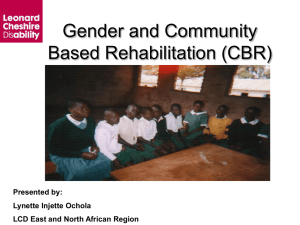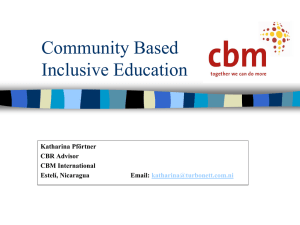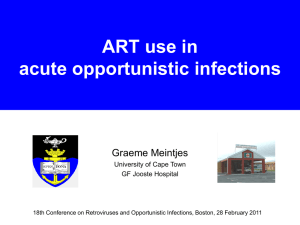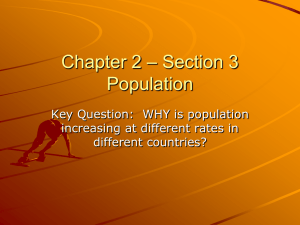HIV and TB - American Lung Association
advertisement
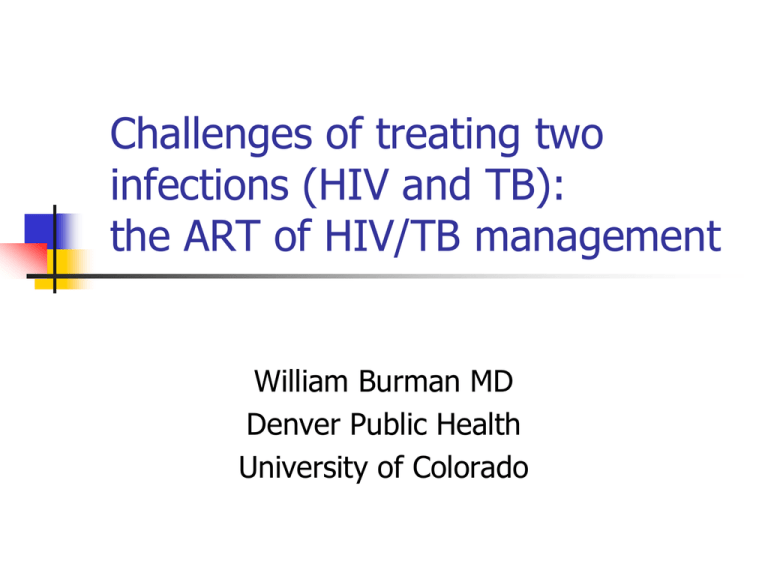
Challenges of treating two infections (HIV and TB): the ART of HIV/TB management William Burman MD Denver Public Health University of Colorado Case 1 27 y/o man from Ethiopia, admitted with cough, fevers, and 20 lb. weight loss over one month Sputum - rare AFB HIV-positive, CD4 - 18, viral load > 1,000,000 Dramatic initial improvement with IRZE Case 1 1. Should antiretroviral therapy be started during TB treatment? 2. When during TB therapy should antiretroviral therapy be started? 3. What regimens can be used for co-treatment of HIV and TB therapy? Survival of persons with HIV-related TB in the pre-HAART era – San Francisco N Engl J Med 1991; 324: 289-94 Complicating factors: antiretroviral therapy during TB therapy Need for coordination between TB and HIV treatment programs Challenge of adherence to multidrug therapy for both diseases Overlapping drug toxicity profiles Drug interactions Immune reconstitution (paradoxical) reactions SAPiT: Starting Antiretroviral therapy (ART) in three Points in TB Primary Objective: To determine the optimal time to initiate ARVs in TB patients Inclusion Criteria: Smear pulmonary TB HIV positive with CD4 count < 500 cells/mm3 Effective contraception (efavirenz) Endpoint 10 – all-cause mortality Karim S, et al. N Engl J Med. 2010;362:697-706 Initiation of ART during vs. after TB treatment: SAPIT Abdool Karim S, et al. New Engl J Med 2010; 362: 697-706 Mortaltiy rate (per 100 person-years) Effects of timing of ART on mortality, by baseline CD4 cell count: SAPIT 18 16 14 12 10 8 6 4 2 0 21/137 22/281 6/86 2/186 < 200 Integrated 200-500 Sequential Abdool Karim S, et al. New Engl J Med 2010; 362: 697-706 Mortaltiy rate (per 100 person-years) Effects of timing of ART on mortality, by baseline CD4 cell count: SAPIT 18 16 14 12 10 8 6 4 2 0 21/137 All patients with HIV-TB should receive ART during TB treatment 22/281 6/86 2/186 < 200 Integrated 200-500 Sequential Abdool Karim S, et al. New Engl J Med 2010; 362: 697-706 Competing risks in the timing of ART during TB treatment Immediate (< 2 wks) Early (2 months) Benefits: • ↓ risk of other OIs Benefiits: • ↓ risk of IRD Risks: • ↑ adverse effects • ↑ incidence of IRD Risks: • ↑ incidence of OIs • feasibility Mortality General schema for CAMELIA, STRIDE, and integrated arms of SAPIT Primary endpoint “Immediate ART” TB treatment (within 2 weeks) ART HIV+ TB TB treatment “Early ART” (2-3 months) ART 0 8 24 Study week Key characteristics of trials of timing of ART during TB treatment Study Setting Key enrollment criteria Median CD4 (IQR) Primary endpoint Cambodia Smear +, CD4 < 200 25 (10 - 56) Death STRIDE Multinational Clinical TB, CD4 < 250 77 (36 – 145) AIDS or death SAPIT South Africa Smear +, CD4 < 500 150 (77 – 254) AIDS or death CAMELIA N Engl J Med 365; 2011; 1471-1501 Effect of ART timing on death (CAMELIA) or death/AIDS (STRIDE, SAPIT) 18 16 14 12 10 8 6 4 2 0 34% ↓ p=0.004 19% ↓ p=0.45 11% ↓ p=0.73 CAMELIA STRIDE Immediate N Engl J Med 2011; 1471-1501 SAPIT Early Relationship between median baseline CD4 count and the effect of immediate ART on death (CAMELIA) or death/AIDS (STRIDE, SAPIT) 35 160 P = 0.004 140 30 120 P = 0.45 25 100 20 80 15 P = 0.73 60 10 40 5 20 0 0 CAMELIA N Engl J Med 2011; 1471-1501 STRIDE SAPIT Median baseline CD4 cell count % decrease in death/AIDS with immediate ART 40 Effects of ART timing on outcomes in CAMELIA and patients with CD4 < 50 in STRIDE and SAPIT 30 42% ↓ p=0.02 68% ↓ p=0.06 STRIDE SAPIT 25 20 15 34% ↓ p=0.004 10 5 0 CAMELIA Immediate N Engl J Med 2011; 1471-1501 Early Effects of ART timing on death/AIDS among patients with CD4 > 50 in STRIDE and SAPIT 14 AIDS or death 12 p=0.67 10 p=0.34 8 6 4 2 0 STRIDE Immediate SAPIT Early N Engl J Med 2011; 1471-1501 IRD Effects of ART timing on Immune Reconstitution Disease among patients with CD4 > 50 in STRIDE and SAPIT 18 16 14 12 10 8 6 4 2 0 p=0.02 p=0.009 STRIDE Immediate SAPIT Early N Engl J Med 2011; 1471-1501 Effect of ART timing on survival of patients with TB meningitis Median CD4 ~ 40 (16 – 100) 60% + CSF culture KM survival estimates at 9 months 35.2% in immediate arm 40.3% in deferred arm Hazard ratio 1.1 (95% CI 0.8 – 1.6), p = 0.52 Early ART Immediate ART Similar in per protocol analysis Török et al, 41st Union World Conference on Lung Health, Berlin Nov 2010 Percentage of patients Effect of ART timing on risk of adverse events in patients with TB meningitis p = 0.04 100 90 80 70 60 50 40 30 20 10 0 Grade 3 or 4 Immediate Grade 4 Early Török et al, 41st Union World Conference on Lung Health, Berlin Nov 2010 Timing of ART in patients with TB Advanced AIDS (CD4 < 50): immediate ART (within 2 weeks) improves survival Markedly increased risk of IRIS, including fatal IRIS events Overall survival benefit despite IRIS CD4 > 50: early ART (~ 2 months) provides good balance of competing risks of death/AIDS vs. IRIS Caveats CNS involvement – no benefit to immediate therapy, and there may be increased risk (Clin Infect Dis. 2011;52:1374-83) Programmatic complexities of early ART Programmatic challenges of immediate ART during TB treatment Rapid HIV diagnosis Rapid provisional diagnosis of TB Rapid way to identify those in need of immediate ART: CD4 cell count, BMI, clinical status ART available in settings where TB is diagnosed (hospital or clinic) Training in diagnosis and management of IRD events Adverse events during treatment of HIV-TB 54% (99/167) had adverse events, 34% interrupted TB or HIV therapy Common adverse events Peripheral neuropathy (21%) - more common with use of stavudine Skin rash (17%) - TB drugs (16), co-trimoxazole (7), nevirapine (2), other drugs (4) hepatitis (6%) - TB drugs (6), unknown (5) AIDS 2002;16:75-83 Example of drug-drug interactions in HIVTB care: atazanavir with rifampin HIV Medicine 2007;8:131-4 Effect of rifampin on exposure (AUC) of NNRTIs % of normal AUC 100 80 78 69 60 40 20 0 Efavirenz Nevirapine Effect of EFV dose (600 vs. 800 mg) on mid-dose levels, patients on RIF Outcomes at 48 wks On EFV 600 mg – 81% 800 mg – 74% VL < 50 600 mg – 91% 800 mg – 87% AIDS 2005;19:1481-6, AIDS 2006;20:131-2 %with viral load > 400 Virological failure of efavirenz-based ART, among patients with and without rifampin for TB 14 11.5 12 10 8 8.1 8 6.4 10.4 5.7 6 4 2 0 6 12 18 Months of co-treatment TB No TB JAMA 2008; 300: 530-9 Case #2 - Intubated in the ED 38 year old man sent from jail – 1 wk of fevers, cough, dyspnea BP – 85/36 P – 100 T – 38.8 ABG – pH – 7.21, PCO2 – 29, PO2 - 38 Intubated for CV instability, acidosis, hypoxia PMH – Meds – trim/sulfa, azithro, acyclovir AIDS CD4 – 2, VL – 10,200 Crack cocaine abuse, frequent incarcerations PPD negative 3 mos. prior Hospital course Initial treatment – trim/sulfa and prednisone Sputum DFA – negative for PCP Sputum AFB – strongly positive Started on parenteral INH, RIF, levo, amikacin Extubated, switched to oral IRZE Culture – susceptible M. tuberculosis In the ID Clinic 3 weeks into TB treatment – first ID Clinic visit since TB diagnosis Current TB treatment - IRZE 5 days/wk by DOT Living situation – SRO provided by TB program Drug use – clean and sober Interested in ART, but very worried about side effects and being experimented on ART history 6 years ago – brief multidrug regimen, no records, patient unable to identify meds 18 months ago – tenofovir / 3TC / EFV Initial suppression to < 50 copies/ml CD4 from 4 to 24 Subsequent virological and immunological failure 2o nonadherence Genotype: L100I, K103N (EFV), M184V (3TC) Patients who cannot be treated with EFV-based ART Efavirenz intolerance Resistance to efavirenz (other 1st-generation NNRTIs) Pregnancy (at least for the first 1-2 trimesters) Very young children (< 3 years) Comparison of the effects of RIF vs. RBT on trough concentrations of boosted PIs % of noormal trough concentration 200 175 150 120 117 113 100 50 1 2.5 ND ND 0 LPV/r ATZ/r rifampin DRV/r FPV/r rifabutin AAC 2204;48:1553-60, AAC 2006; 50:3336-42, AAC 2010;54:4440-5, AAC 2008;52:534-8, Effect of protease inhibitors on serum concentrations (AUC) of rifamycins PI Rifabutin Rifampin Ritonavir 400% unchanged Indinavir 270% unchanged Nelfinavir 200% NR Amprenavir 400% NR Lopinavir/ritonavir 300% NR Atazanavir 250% NR Clin Infect Dis 1999; 28: 419-30 Clinical relevance of increased rifabutin concentrations due to ritonavir Adverse effect Arthralgia Joint stiffness Uveitis Leukopenia % of patients on % of patients ritonavir + rifabutin on ritonavir 9.2 4.1 4.7 38 0.6 0 0.6 19 11th International Conference on AIDS; abstract Mo.B171 Rifabutin PK with lopinavir/R in TB patients (n = 16) PK parameter RBT 300 mg/day RBT 150 mg QOD + LPV/r RBT 150 mg/day+ LPV/r Median AUC (exposure) 3026 2307 5010 Median Cmax (peak) 297 168 311 Naiker S, et al. 2011 CROI, abstract 650 Rifabutin and TB therapy Rifabutin is as active as rifampin No dose adjustments of ART needed for commonly-used drugs (ATZ, lopinavir/R) Decrease RBT from 300 mg daily to 150 mg daily when given with boosted PIs Give remainder of TB drugs daily Caution – RBT dose would be inadequate if patient stopped PI HIV, TB drug interaction - summary Drug interactions in HIV-TB are regrettably complex, but should not prevent HIV-TB cotreatment Co-treatment regimen of choice: rifampinbased TB treatment + efavirenz-based (standard dose) ART Drug interactions should be managed, not avoided – use a rifamycin-based regimen New drug interaction guidelines at http://www.cdc.gov/tb/TB_HIV_Drugs Case 1 – Chest x-ray response to therapy Diagnosis 2 months Case 3 – Chest x-ray response to therapy - II 3 months Started antiretroviral therapy at 8 weeks of TB therapy Developed fever, cough, left pleuritic chest pain 10 days after starting HAART Types of immune reconstitution inflammatory syndrome (IRIS) events in HIV-TB • Hectic fever • New or worsening adenitis - peripheral or central nodes • New or worsening pulmonary infiltrates, including respiratory failure • New or worsening pleuritis, pericarditis, or ascites • Intracranial tuberculomas, worsening meningitis • Disseminated skin lesions • Epididymitis, hepatosplenomegaly, soft tissue abscesses Association between timing of ART and risk of IRIS event (SAPIT) 42% hospitalized 22% hospitalized 5% hospitalized Ann Intern Med 2012; 157:313-24 Association between timing of ART and risk of IRIS event (SAPIT) Median duration - 71 days Median duration - 34 days Median duration – 24 days Ann Intern Med 2012; 157:313-24 IRIS in the CAMELIA study (median CD4 of 25) Immediate ART increased risk of IRIS (33% vs. 14% for early ART) Similar timing of IRIS events (14 vs. 16 days after starting ART 6 deaths, all in the immediate arm, were attributed to IRIS events However, immediate ART was associated with a lower risk of death (8% vs. 14%) N Engl J Med 2011; 365: 1471-81 IRIS events - implications for use of antiretroviral therapy (ART) Those who need ART the most (patients with low CD4 cell counts) have higher risk for an IRIS event and for a serious IRIS event Delaying ART decreases risk of severe paradoxical reactions, but increases risk of another OI or death Anticipate IRIS events – discuss beforehand with patient and other care providers Schedule early follow-up after starting ARV detect and manage IRIS events Management of IRIS Anticipate IRIS events – warn patients and other care providers Rule out other possible causes – bacterial infections, a 2nd OI, inadequate Rx for OI, drugresistant pathogen For relatively severe manifestations, prednisone is reasonable 1 mg/kg (1.5 mg/kg with rifampin), tapering over 4-6 weeks What’s happening in the clinic? Starting ART in TB patients in London, 1998-2007) British recommendations (at that time) CD4 < 100 – at 2 weeks CD4 100-200 – at 2 months CD4 > 200 – after TB treatment 83 patients eligible to start ART 20 patients (24%) started ART at the recommended point in TB treatment Thorax 2008;63:935 Reasons for the delay in starting ART among patients with CD4 < 100 Patient-related reasons: Refused to start Fear of side effects of ART Poor adherence Physician-related reasons: Serious side effect of TB treatment Concern about ART side effects / IRIS Presence of another illness Seriousness of the manifestations of TB 7 (21%) 2 (6%) 3 (9%) 8 6 4 5 (24%) (18%) (12%) (15%) Thorax 2008;63:935 Starting ART during TB treatment – summary of the steps required Start TB therapy, deal with initial side effects Help patient deal with the diagnosis of two stigmatizing diseases Start cotrimoxazole, deal with initial side effects Assess readiness for HAART Coordinate start of ART (~ 2 weeks for CD4 < 50, ~ 2 months for CD4 > 50) Use DOT visits to adherence with HAART Anticipate and manage immune reconstitution events Summary – treatment of HIV-related TB: issues with antiretroviral therapy Should antiretroviral therapy be used during TB treatment? What regimens can be used for co-treatment of HIV and TB? Yes, for all patients Preferred: efavirenz-based HAART + rifampin-based TB treatment Alternative: PI-based HAART + rifabutin-based TB treatment When should HAART be started? 2 weeks (CD4 < 50 to 2 months after starting TB treatment Two infections; one patient GLOBAL PARTNERSHIP TO STOP TB





